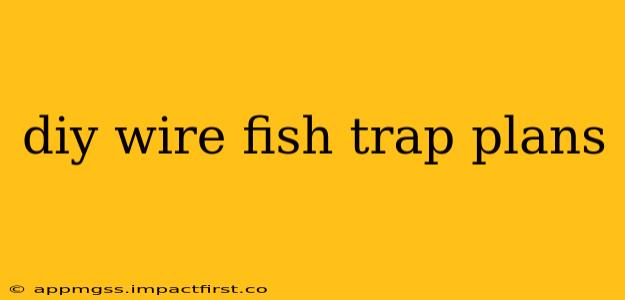Building your own wire fish trap is a rewarding project that connects you to a time-honored fishing tradition. It’s a surprisingly simple process, requiring minimal materials and tools, and offers a sustainable way to harvest fish. This guide provides detailed DIY wire fish trap plans, addressing common questions and offering tips for success.
What kind of wire is best for making a fish trap?
The best wire for making a fish trap is galvanized wire. Its durability resists corrosion from water exposure, crucial for a trap that might be submerged for extended periods. Look for a gauge that's strong enough to hold its shape but flexible enough to work with – 16-gauge is a good starting point. Avoid using wire coated with anything that could be harmful to the fish or the environment.
What are the different types of wire fish traps?
Several designs exist, ranging in complexity. Simple funnel traps are ideal for beginners, relying on a single entrance that fish can easily enter but struggle to exit. More complex designs incorporate multiple chambers or baffles to increase trapping efficiency. The specific type you choose will depend on your skill level and the size of fish you target. Online resources and books on traditional fishing methods offer visual guides to various designs.
How do I make a simple wire fish trap?
A basic funnel trap is relatively straightforward. You'll need your chosen wire, wire cutters, pliers, and possibly a small amount of additional material for reinforcement or a secure closing mechanism (such as a simple latch). The construction involves bending and weaving the wire to create a cone shape with a narrow opening acting as the entrance. Detailed visual tutorials are readily available online; searching for "DIY wire fish trap tutorial" will yield numerous results. Remember to leave enough space for the fish you intend to catch to comfortably enter, but design the exit to be too narrow for them to easily escape.
What are the dimensions for a wire fish trap?
The dimensions of your trap will depend on the size of fish you intend to catch. A smaller trap, suitable for smaller fish, might have a diameter of 12-18 inches at the widest point and a length of 18-24 inches. Larger traps can be significantly bigger but will require more wire and more robust construction. It's essential to adjust the dimensions to accommodate your target fish species. Again, online resources often include dimension guides paired with their designs.
Is it legal to use a homemade wire fish trap?
Legality varies widely depending on location and specific regulations. Before constructing and using a wire fish trap, always check your local and state fishing laws. Regulations might include size limits on the fish you can catch, licensing requirements, and restrictions on the type and number of traps allowed. Contact your local fish and wildlife agency for clarification on applicable rules.
How do I bait a wire fish trap?
The bait you use will depend on the type of fish you are targeting. Commonly used baits include smaller fish, worms, insects, or commercially available fish attractants. Secure the bait within the trap in a way that attracts fish but doesn't allow it to easily escape before the trap is set.
How often should I check my wire fish trap?
The frequency of checking your trap depends on several factors, including weather conditions, the activity of your target fish, and local regulations. Checking regularly, at least once a day, ensures the well-being of any caught fish and allows for timely harvest. Leaving trapped fish unattended for extended periods is inhumane and may violate local laws.
By carefully following these instructions and researching local regulations, you can successfully build and utilize your own DIY wire fish trap, enjoying the satisfaction of catching your own fish using time-tested methods. Remember always to fish responsibly and adhere to all local laws and regulations.
